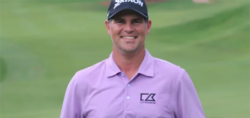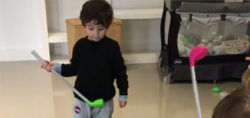A Timeline On How The Masters’ TV Broadcasts Evolved From Bit Player To Best In Show

The Masters is easily the most-watched golf tournament every year. The familiarity of the holes, blooming azaleas, the CBS broadcast crew and even the ultra-awkward Green Jacket ceremony in Butler’s Cabin are must-see for even non-golf aficionados. But it didn’t begin that way. In fact, then Augusta National emperor Cliff Roberts nearly had to beg the media to cover the event.
It wasn’t until the telegenic Arnold Palmer lit up the screen that The Masters attracted such broad appeal (it broadcasted only holes 15-18 in 1956). GolfWorld.com’s John Strege writes an excellent timeline on how the “toonament” went from bit player to the best and most watched event in all the land.
The Masters’ tradition of “limited commercial interruptions” that continues to this day began with the 1958 telecast, when American Express came aboard as its first sponsor. “The average golf fan takes his golf pretty seriously,” Roberts wrote. “Nothing but extreme annoyance could result from untimely, too long or too frequent commercials.”
1960
Frank Chirkinian had begun producing CBS’ Masters telecasts the year before and his impact was immediate. In 1960, he introduced scoring as we follow it today, in relation to par, rather than total strokes. Here was his explanation:
“The first year we did the Masters was 1959, and it was maddening,” he told Loran Smith of Athens Online. “The scores were posted with cumulative scores. When a player finished a hole and his cumulative score at that point was 215, that was what went up on the scoreboard. You might have one player with 215 in a playing group and the other player’s cumulative score might be 240. Nobody knew what was going on.”
Eventual 1986 Masters winner Jack Nicklaus was a mere afterthought on Sunday by Chirkinian until associate producer Lance Barrow kept pestering his boss to show The Bear’s birdie barrage.
When CBS’ telecast of the final round began, Jack Nicklaus was not a factor. Obviously, there was no Internet then, no way to check scores or to know anything going on other than what CBS was showing and executive producer Frank Chirkinian had no interest in showing Nicklaus. It was more than 24 minutes into the telecast when CBS showed him for the first time, another 15 minutes or so before showing him the second time.
Chris Millard recounted in Golf Digest how the exchange between Chirkinian and his young associate director Lance Barrow went down:
“The protégé felt compelled to advise his boss of Nicklaus’ stirring. Feeding the cantankerous Chirkinian tidbits was like feeding a shark—things could go badly—but Barrow pressed ahead. Barrow was seated only a few feet to Chirkinian’s left in the sun-starved production truck, lit by the blue haze of some 60 television monitors. ‘Frank,’ said Barrow, ‘we’ve got Nicklaus with a birdie at nine.’
“Predictably, the boss was dismissive. ‘I don’t need him,’ Chirkinian snapped. Nicklaus proceeded to birdie No. 10 with a 25-foot bomb. The husky, intrepid Barrow, nicknamed ‘Buddha’ by Chirkinian, again tapped his boss on the leg. ‘We’ve got Nicklaus with a birdie at 10, Frank.’
“‘I don’t need him,’ growled Chirkinian. ‘Quit telling me about Jack! Nicklaus means nothing in this golf tournament!’
“When Nicklaus birdied the 11th hole, Barrow again summoned his nerve. He gently tapped his mentor on the leg and said, ‘Frank, uh, I know that Jack means nothing to this golf tournament, but he just birdied 11 … and he’s two off the lead.’
“Chirkinian glanced at Barrow and said, ‘Cue it up, Buddha.’”
CBS did show the birdie at 10, on tape. “Earlier, Jack Nicklaus for birdie to go four-under par,” CBS’ Bob Murphy said. When the putt dropped, Murphy exclaimed, “and the Bear, the Bear is stalking.”
And the rest is broadcast history, including Verne Lundquist’s simple, but enduring call when Nicklaus holed a birdie putt at 17 to take the outright lead: “Yessir!”
Meanwhile, Jenkins in Golf Digest summed up the collective angst among the writers in the Quonset hut afterwards: “On that final afternoon of the Masters Tournament, Nicklaus’ deeds were so unexpectedly heroic, dramatic and historic, the taking of his sixth green jacket would certainly rank as the biggest golf story since Jones’ Grand Slam of 1930. That Sunday night, writers from all corners of the globe were last seen sitting limply at their machines, muttering, ‘It’s too big for me.’ ”
It’s a long read but worthy of your time as we ready ourselves for maybe the most anticipated of all Masters weeks.






